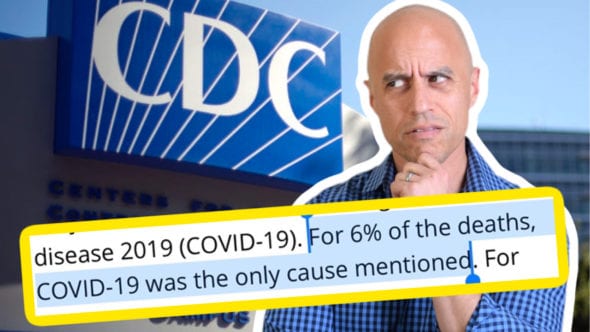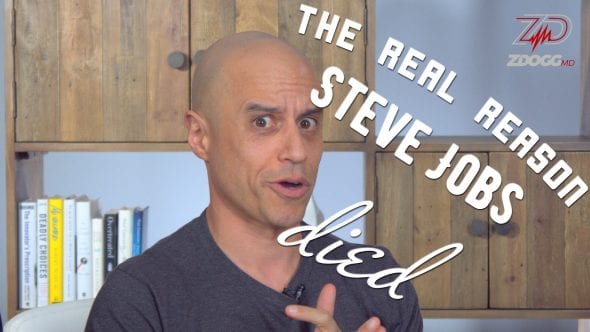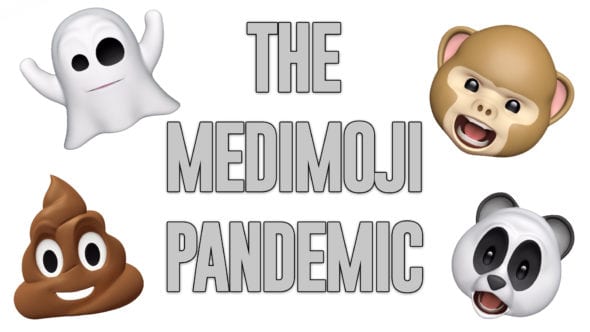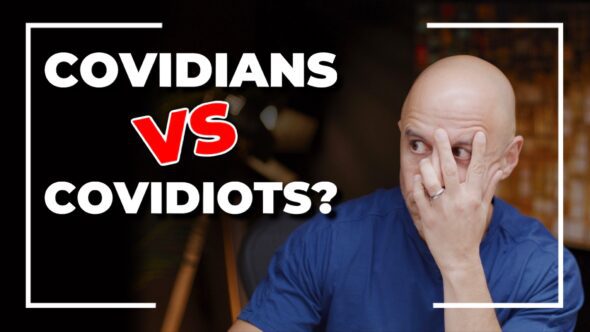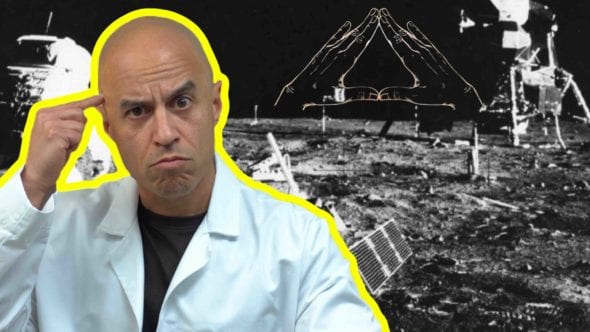Preliminary efficacy data is truly encouraging, but here’s how we can best understand what it means (and DOESN’T mean).
Here’s a decent NY Times summary.
And here’s a prior video I did on vaccine challenges with Dr. Paul Offit.
Transcript below!
Hey everybody. It’s Dr.Z, welcome to The ZDoggMD Show. We’re gonna talk about Pfizer’s vaccine results today for coronavirus.
So they announced today that their preliminary data looking at 94 patients out of the 40 odd thousand that are enrolled in this trial, for their mRNA based vaccine, which we’ll talk about. Of those 94, who actually were infected with coronavirus, very few of them were in the arm that actually got the vaccine, which means they’re calculating a 90% efficacy for that vaccine.
Now this is making news all around the world because we’re hanging our hopes on a vaccine and have been for some time, since it looks like other measures particularly in the United States now looking like in Europe as well, are failing to control, the virus largely due to we don’t actually have other measures that are working well. So mask wearing, social distancing hygiene, testing, not really consistent. And so, people are really hoping that the vaccines going to help.
So what I wanna do in this live show is talk about what it means, what the data so far means and what we’re missing, and what we ought to do. All right. So what does it mean? Tons of people enrolled in this trial by Pfizer, and remember there are about 10 vaccines in the works across different companies Moderna is another one, AstraZeneca is another one. Pfizer is interesting because they did not take federal money up front for this as part of Operation Warp Speed. Although they were guaranteed a certain amount like to the tunes of billions, of purchases of the vaccine if they were successful when they deliver the vaccine. So, they haven’t really been part of warp speed in the sense that they haven’t gotten a bunch of upfront federal money, like say Moderna has, okay.
They have a vaccine candidate that will works like this. There’s a protein on the surface of the virus called the spike protein. That can generate an immune response in the form of antibodies from a human host. So the antibodies, if they bind to the spike protein they prevent the virus from entering cells and trigger the immune system to knock it out of action (simplifying it). There was some question as to, well, most of the vaccines, actually I think all of the vaccines in development are using a spike protein target. There are other protein targets on this virus and we’ve never really made a vaccine against coronavirus. So the hope was we chose the right general approach with the right protein, right?
So they chose a spike protein, and we still didn’t know, they chose the spike protein and what they found, sorry, I’m just looking at your comments, making sure the stream is working. What they found was that you can make this spike protein either the antibodies to the spike protein either by injecting an inactivated virus, producing a purified, spike protein in the lab and then injecting it, using another virus to inject the RNA that then tells your human cells to make the spike protein and then make antibodies against it.
So what these guys did is an mRNA approach. And this has never been approved for a vaccine before. It’s a new technology, right? Although they’ve been working on it for at least a decade, what you do is you take messenger RNA which is a type of RNA. It’s a genetic code, and it tells cells to make proteins. There’s parts of the cells that will make proteins based on that mRNA code. What Pfizer did and Moderna is doing as well, is they’re taking their laboratory, making this messenger RNA little segment that just codes for the spike protein. And they’re wrapping that in a lipid, which is like a little fatty layer a little membrane, kind of like a cell membrane. And what that layer does is it protects that little mRNA and allows it to fuse with the cell enter human cells get transcribed into protein, those proteins then trigger the human body, because they’re foreign, trigger the human body to make antibodies against them. And that spike protein that has made that way, you generate antibodies and then have an immune response. That’s theoretically how this works.
And it’s interesting because it allows you quickly to make a vaccine based on just, you just need that mRNA and the vehicle to deliver it. But it’s not been done before for human vaccines that have actually been approved and are used out in circulation. So this was a big bet, but does it work? Is it safe? Is it stable? These are the questions we wanna ask.
So, what they did with this trial is they enrolled a bunch of people and they said, okay, half of y’all are gonna get saline injections. And half of y’all are going to get this mRNA vaccine candidate, the researchers, the patients, the people doing the trial don’t know, they both don’t know who’s getting what.
The people who know are an independent committee that’s reviewing the data. That is a double blinded randomized controlled trial. What that means is both the study participants and the researchers don’t know who is in the placebo arm and who is in the treatment arm. And that’s important because if you know who’s who you start introducing bias, right? So that’s well done, they’re randomized. So you take your population and you randomly assign them to placebo or vaccine. That’s it important because it eliminates certain forms of bias. If you’re cherry picking, who’s gonna get a vaccine and who’s gonna get a placebo like they, you know, in these retrospective trials, things like that. A lot of times there’s cherry picking. You can introduce a ton of bias. So they did that correctly.
What kind of study population is it? Well, they’re saying in the US ,30% of the study population is diverse in terms of ethnically, racially, gender, et cetera, okay. That’s important. It’s a global study. So actually globally, it’s more like 42%. So you’re not just studying it in white men which is important because you’re trying to translate this into a vaccine that’s applicable across different races, ethnicities genders, and also ages, which we’re gonna talk about.
Now that is crucially important with this disease because it seems to preferentially affect minority groups particularly in the US. African-Americans and Latinos particularly Asian, Pacific Islanders, et cetera. So you want that trial to be robust in terms of who’s enrolling, otherwise it makes no applicable sense to the real world.
Okay, so they then randomized these guys. Now the tricky part with this vaccine is it’s two injections, a few weeks apart. So you take your first injection. Then three weeks later, you get your second injection. I believe it’s three weeks, because about a week after that at 28 days, that’s when they wanted to really see, okay, is there efficacy now, because you’ll have had both vaccinations in the sequence.
Now, the other difficulty with this vaccine, which we’ll talk about is it needs to be stored extremely cold temperatures, minus 94 degrees, Fahrenheit or 70 degrees Celsius. That’s really, that’s not your fridge at home. That’s a specialized refrigerator, a freezer that will keep it that cold. So, that being said, they then looked at the data. Now they wanted to look at it earlier, like in October when they only had 32 positive cases to look at, but they decided after talking to FDA, that that wasn’t gonna be very compelling data for a variety of reasons. They said, okay, we’re not gonna do that. We’re gonna wait till we get 64 cases. Well, it turns out by the time they made that decision they already had 94 or some odd cases. And they then handed it off to this independent committee to look at preliminary peek at what is the data showing now?
So far safety, they’ve not had major adverse events meaning they’ve had headaches and fevers and muscle aches and chills, the kind of things that many adult vaccines will cause, although this seems to cause them a little bit more than say your pneumonia vax or something like that, but nothing serious in the trial so far. Now this is very early, all right? So no big safety signal in the Pfizer trial. And we’ve read about the other trials, having had pauses because of an individual getting something that still is being figured out, right? But with this particular trial, nothing like that.
So what did they see for efficacy? What they saw was in those 94 positive cases out of the however many tens of thousands they’ve analyzed so far, very few who were vaccinated because then they unblinded it for the committee. Very few who are vaccinated got sick, got the disease. Then they calculated based on those numbers and statistics that it is 90% efficacious.
Now, what does that mean? Okay. Already, it’s telling you that if most of the people who got sick got the placebo, there’s a difference there. And they have enough statistical power, there’s enough numbers to say, that’s not due to chance. That’s crucially important. You wanna make sure the trial is big enough. 44,000 people, they originally aimed at 30, they got up to like think 43, something almost 44. That’s a lot of people. That’s enough to make that ascertainment even at those small numbers. So, we’re seeing signal that says, it looks like a 90% efficacy so far for this vaccine.
Now, let me put that in context, influenza is somewhere between 40 and 60% efficacious, the FDA set a bar of 50%. They’d like to see a 50% efficacy to really approve a coronavirus vaccine and make it useful. This is 90%. And it vastly exceeded what their expectations were for this approach. That is very encouraging, very encouraging that the vaccine is actually effective, meaning it generates an immune response, fine. You see that in earlier phase, you know, phase two, phase three trials, you can see, okay, it’s generating an immune response, but does it prevent coronavirus infection in real humans in real life? And the answer appears to be yes, in this trial, in the early phase, that’s key, but what does it not tell us?
So it tells us we better keep going. Now what Pfizer is planning to do is, in a couple of weeks, they’re gonna review the safety data, because then they’ll have reached a milestone of two months after the last of the second series of the vaccinations for enough people for about half the trial members. At which point they can say, okay, here’s our safety data so far. Two months out, this is what we see. Because you would expect major adverse events to present within that period of time, all right?
So what does it not tell us? What do we not know? Why should we not be, you know, popping corks of champagne although very encouraged? well, this is what it doesn’t tell us. It doesn’t tell us, were the cases that we prevented with that vaccine, potentially the severe cases or are they just asymptomatic positive cases or mild symptom cases. In other words, if you are going to get very sick from coronavirus, would this vaccine have prevented that? Or will it only prevent people who weren’t gonna that sick anyways, like asymptomatic mild symptoms, like 60 to 80% of infections are, is it only preventing those? Cause if it’s just preventing those that’s less interesting to us, isn’t it? Because people will still die of the disease.
The second thing it doesn’t tell us yet, is does it prevent people who are exposed to the virus, sure, they don’t test positive but can they still actually have a low-level infection and infect others? We don’t know the answer to that. The other thing we don’t know, that’s very important is who is it preventing the infection in? Pfizer’s trial started enrolling people 18 and over and included people 65 and over I believe. They then expanded it later to go down to 16 years old. And they’re starting to look down into the twelve-year-old range. So they didn’t include frankly children yet, but they did include older people. What we haven’t seen in this early data is what they call a subgroup analysis. In other words of the people who got infected, how many of them were older? How many of them had comorbidities like diabetes, hypertension, congestive, heart failure, immune compromised, asthma, COPD. How many again, how many of them were minorities? How many of them were non-minorities and how many of them were older with risk factors?
So is the virus efficacious particularly in our highest risk populations, people with chronic disease and older patients. And that’s what we really will need to know when the final or future data comes out. Because again, you can have us 90% of efficacious vaccine in 30 year olds who were only gonna get mild disease anyways but that doesn’t help our 65 year old who’s gonna end up on a ventilator on a ventilator or dying or a long hauler. So that’s information that has yet to come out. And that will temper our understanding of this.
The other things that we don’t really know so far is, how are we gonna manage the fact that this particular vaccine needs really cold temperatures to distribute? So Moderna’s doesn’t need as cold of temperatures. We don’t have data out yet on them, but this is quite cold. Now they’re working on making it more stable, so it doesn’t require such cold temperatures. But how are you going to get that to Africa or India or rural areas, or even clinics out here that don’t have the specialized refrigeration necessary. And it just limits where you’re not gonna give it, you know more, you know vaccination fare. You’re gonna have to give it in more controlled circumstances. So that’s gonna limit us.
The other problem with this is, Pfizer says they can have 50 billion doses available by end of year and maybe 1.3 billion in 2021. But how are we gonna get those distributed and to whom? So let’s say it’s safe and efficacious. The signs are saying yes, your little eight ball that you shake, it says “signs say yes.” How, who are we gonna give it to first? Well, I would say it looks like healthcare professionals , people at highest risk ,teachers maybe if schools are open groups, with chronic disease and the elderly would be our highest priority. And then everybody else and then you have to look at well, should we be giving it to minority groups that are hardest effected first? These are gonna be distribution almost rationing questions with any vaccine situation, which is good that we have multiple candidates coming out, right?
The second question is, should this then change how we behave right now? Because heck we we’re gonna have a vaccine that works, right? Well, we don’t know that this is still preliminary. What it tells us is that, it’s still gonna take months to get this in the hands of people who need it. Our infection case rates are going through the roof. Hospitalizations are rising, Deaths are rising, not as much, not as much. And it’s gonna be important to look at that data, right? But in the meantime, before we get this vaccine into people’s bodies and have some efficacy from it, we better do what everybody’s been saying, we should be doing, be doing from the beginning not from the very beginning, WHO, Fauci, et cetera. Weren’t talking about masks early on, but now we are, wear a mask when you can’t socially distance, keep some physical distance, wash your hands. And we should have testing for people to allow for contact tracing and all of that.
So, that stuff we’ve been saying and we should continue to do that. Because otherwise we’re all gonna be infected well before any vaccine comes out. Now the other thing we don’t know, that’s very important is how long does this efficacy last? Right now we’re so early, we can’t say it lasts more than a few weeks or months. So that’s gonna require longer-term data, because if you end up vaccinating a bunch of people, and then the vaccine efficacy doesn’t last more than a few months then you’re gonna have to have revaccination until there’s enough contact tracing and control that you slow down the spread. So let’s hope that it lasts long. And there’s some signs that I think it might actually do quite well.
Maybe it’s a yearly vaccine. That would be a bummer because it’s a two shot series. Maybe the second time you get it, you only need one who knows. And the other question is children. If we’re sending kids back to school then we better start getting data in kids under 12. Because we wanna see is it safe and effective? And I remember when you’re giving kids a vaccine, these kids don’t normally get sick or die from this normally, right? They’re very, very minimally affected. They can still spread it. You’re giving them a vaccine. You better hope that vaccine is safe. Because otherwise your cure is worse than the disease for those children.
Now it may prevent older people from getting sick, but you don’t want adverse events in children that can lead to a lifetime of trouble. So that is where we are on the vaccine. Now let’s take some question.
Alyssa Swink says, would you get this vaccine Dr. Z? Yes. So here’s how I think about this. When I see the, and by the way I spoke with Dr.Paul Offit today, who’s my go-to source. He’s quoted everywhere online right now about this vaccine, and he and I talked about this via email and basically I’ve filled you in on what he thinks. He also says it’s very encouraging for other vaccine delivery vehicles because it says, if we can just generate this spike protein, we can generate an immune response effective in the real world. That’s crucial. And it’s gonna revolutionize vaccine science, right? Would I get the vaccine? As soon as I see the data that says it’s, you know, the final data that says it’s safe and effective, and there’s 30,000, 44,000 person population, you will see me be the first in line and I will publicly livestream my vaccination. I feel that strongly about it. If I feel that the data is not there, I will be the first to tell you, I am not getting this vaccine until I see X, Y, and Z. How do I determine that? Well, I look at the primary data myself, but I also talk to people who I know are not in industry’s pocket, who are deeply knowledgeable about this stuff.
And I asked them the same question hey, are you ready to get this thing? And if they say yes, and I trust them and I look at the data, that’s how I make my decision. And I will tell you what I’m doing. And I’ll be honest because ain’t nobody paying me for this, except for you.
Except which reminds me, that’s how we fund this show. You guys support the show for 4.99 on Facebook, on YouTube. You can make a direct contribution via PayPal. You don’t get anything in return, but an email from me thanking you, but that’s how we are funded. So people say who’s paying you, who’s paying you, who’s paying you, you are. So that’s why we can make independent content. And that’s why I hope you’ll trust me when I talk about these things, right? Because I talk to smart people, but also I don’t have that industry bias. So that being said, let’s take a few more questions here.
You know, the usual anti-vaxxers here. Let’s scroll down and see what we’ve got. Yeah, Please live stream when I get the vaccine, Kristin Ashman. Lisa Willis, how will they determine who gets the first rounds? I’m a teacher and I’m curious how that will be determined. Well, that’s gonna be looked at, I think in collaboration with public health officials and others to look at, okay, first of all, frontline healthcare workers need it. Because hospitals are getting full again. There’s always a question of PPE. They’re the ones at highest risk in those facilities. 1300 odd frontline healthcare workers have died so far of this. So start with them, right? Because again, they’re also a transmission vector if there’s not enough PPE to our most vulnerable patients. So start with them. Then look at people who are at highest risk.
Remember this is a tiered disease, not everybody’s affected equally. Your risk is very different. If you’re 65 and older and have co-morbidities, than a young person with no other comorbidities, you’re much more likely to die in a car accident than you are of COVID 36 times more likely if you’re 24 and under, and you’re twice as likely to die of COVID than you are in a car accident, if you’re 65 and older, that tells you something about who should be getting this vaccine why we need to make sure it’s efficacious in older folks and people with chronic disease.
What about MMR vaccine, Linda Coker? So, here’s another explanation of that. I said, influenza vaccine is 40 to 60% efficacious. I got my flu shot along with my children and wife. It’s still very very helpful. Measles in the MMR is 97% efficacious against measles. That’s tremendous with the two MMR vaccinations. MMR has been associated with resistance to infection by coronavirus associated. So that could mean that it has some ancillary immune boosting effect or people who are likely to get MMR are more likely to stay safe, wear mask physically distance, et cetera. So they’re just more health-conscious and therefore safer. Important, to know, thank you for everyone who is sending stars and supporting us on Facebook.
Kathy says I’m a very pro-vaccine pediatric nurse for years. I’m really not running to get a vaccine made a quickly made vaccine. I’ll be watching you closely to get your opinion. as a healthcare worker, I feel we’ll be pretty much forced to take it whether I think it’s safe or not. Listen, no one should feel forced to take anything. There’s a lot of vaccine hesitancy in the country. And I think because partially because this vaccine has been so politicized we’re worried about elections, worried about this and that, that’s all fading away. I hope what we need to look now is at the pure science of it, understanding that you have to find people that you trust to talk about it. Now, hopefully I’m one of those people. If you don’t trust me, find somebody that you do and listen to them and look at the primary data and understand what it means which means you’re gonna have to learn to review trials. Well, if you don’t wanna do that, find people you trust to do that that aren’t necessarily in industry’s pocket, because it’s very tough cause a lot of people who have that expertise and it isn’t expertise.
Also work with pharmaceutical industry because they can and it’s helpful, but it does introduce bias. At least the perception of bias, right? We’ll want that safety data. We’ll want to look at it very carefully. Because again, if you’re giving healthy people a vaccine that’s why the bar for these trials is very high for safety. It’s crucially high. But now we’re in a situation where again, we’re in a pandemic that’s escalating, it’s actually accelerating. But the question is what’s happening to deaths? What’s happening to ICU hospitalizations? They’re gonna all rise, but are they going to rise to levels where we’re overwhelmed? That has yet to be seen.
All right, what I would you guys to do is share this video. So I’m gonna keep it tight. If you can support the show once via PayPal, you’ll get an email from me or permanently join our tribe where you have discussions with us. We’re gonna go live right after this, in the next 10 minutes to Facebook. And then I repost that to YouTube support tribe so that we go deeper in this stuff. And we have a give and take, and I take a lot more of your comments and it’s a discussion. You get your own discussion forum and all that. Please do that. If you don’t wanna do that, just follow the show. If you’re new, subscribe on YouTube. If you’re watching on YouTube, click the little bell so that you get notifications. Tell a friend, and I love you guys. This is very positive information. It really is. I haven’t been this excited about the prospects for a vaccine from the very beginning. We’ll try to get Paul Offit back on the show to talk more in depth about it. It would be via zoom, which I hate, but we’ll try to do it. And I love you guys until next time stay safe and we are out, peace. Did you think that was dope? Hey, become a subscriber. Click the subscribe button then right to the right of this, a little bell hit that bell. You get notifications. Never miss any of our stuff. I love you guys, we out.
Category
- The ZDoggMD Show (817)
- Featured Videos (189)
- Doc Vader (142)
- Against Medical Advice (128)
- Medical Humor (95)
- Public Service Announcements (87)
- Music Parodies (74)
- Nurses (59)
- Meditation (45)
- The VPZD Show (38)
- ZVlogg (36)
- ZTalks (28)
- ZBlogg (24)



